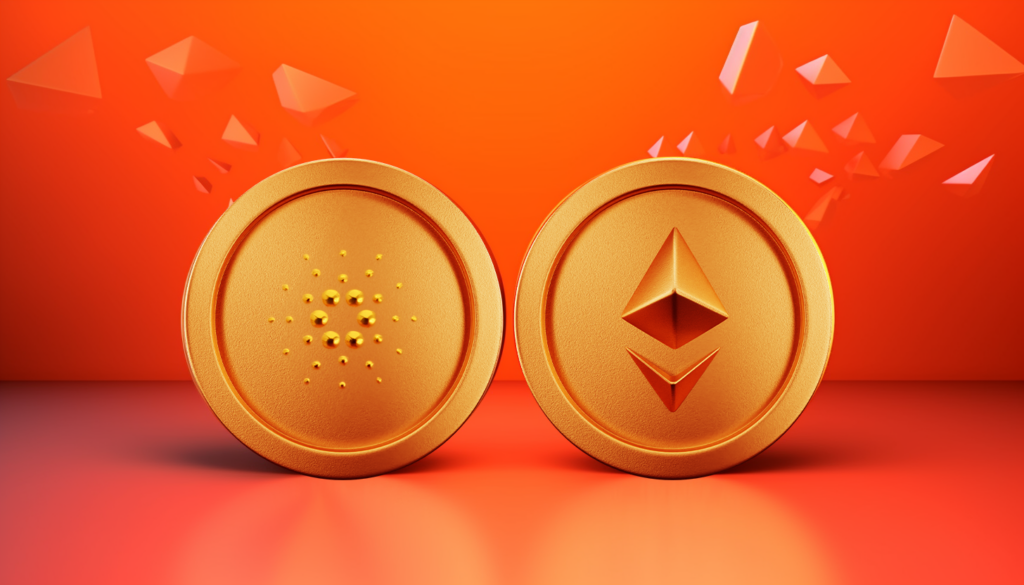
You’ve probably heard of Bitcoin, but today, we’re diving into two other big names in the crypto space: Cardano and Ethereum. Imagine them as two digital cities built with millions of blocks, each with its own way of doing things and its own set of rules. Ethereum has been around for a while and is like that bustling metropolis everyone talks about. On the other hand, Cardano is like a newer, planned city that’s trying to address some of the issues faced by the older ones. By the end of this blog, you’ll have a clearer idea about what each of these digital cities offers and how they stack up against each other.
Short Summary
Cardano and Ethereum Overview: Cardano and Ethereum are leading blockchain platforms with distinct design philosophies. Ethereum, an older platform, introduced the revolutionary concept of “smart contracts,” while Cardano adopts a research-driven approach aiming to address challenges faced by earlier blockchains.
Key Technical Aspects: Both platforms use the “Proof of Stake” consensus mechanism for decision-making. While Ethereum historically faced congestion issues during high transaction volumes, Cardano’s design aims for a more consistent transaction flow. Both platforms support the creation and deployment of smart contracts, albeit with differing tools and methods.
Scalability Challenges and Solutions: Ethereum and Cardano are constantly evolving to address scalability issues. Ethereum has initiated upgrades like its shift to Proof of Stake, while Cardano, with its methodical planning, is progressively rolling out features to ensure platform robustness and efficiency.
Contents
- Cardano and Ethereum: Understanding the Basics
- Key Similarities and Differences
- Scalability and Performance
- Summary
- Frequently Asked Questions
Cardano and Ethereum: Understanding the Basics

Think of blockchains like giant digital Lego sets, where each block contains valuable info and the whole set represents an entire digital world. Cardano and Ethereum are two of the most popular sets out there, but they’re designed a bit differently. Let’s break down these block-by-block worlds and see what makes each of them unique.
Cardano Blockchain
Imagine you’re trying to build the perfect city. You’ve seen some cities with traffic jams, pollution, and other issues, so you want to make sure you avoid those problems. That’s kind of what Cardano is in the blockchain world. It’s like a city built with lessons learned from older cities. Cardano prides itself on being research-driven, meaning a lot of thought and study goes into every block they add. It’s like having city planners, engineers, and architects all sitting down to design every road, park, and building to make sure everything runs smoothly.
Ethereum Network
Now, think of the Ethereum blockchain as the first big city with skyscrapers, highways, and parks. It was revolutionary when it came out. Ethereum wasn’t just about sending digital money like Bitcoin; it introduced the idea of “smart contracts.” Imagine if you had a vending machine that could sell not just snacks, but car insurance, or even a house! That’s the kind of automatic, rule-following system Ethereum’s smart contracts are like. While Ethereum has been a game-changer, it’s faced some traffic jams and growing pains, but that hasn’t stopped it from being a major player in the digital world. It’s like a bustling metropolis that keeps evolving to cater to its growing population.
Key Similarities and Differences

So now you know a bit about Cardano and Ethereum, but how do they really compare? Think of them like two different brands of smartphones. Both can make calls, send messages, and browse the internet, but they might look different, have unique features, or run on different operating systems. Let’s dig into some of the nitty-gritty details like consensus mechanisms, transaction processing, and smart contracts functionality.
Consensus Mechanisms
Consensus mechanisms are the rulebooks for how blockchains agree on adding new info. It’s kind of like the decision-making process in a game. Both Ethereum and Cardano now use a “Proof of Stake” model. Instead of a mad digital race to solve puzzles (like Ethereum’s old “Proof of Work” system), it’s more about holding and validating. Think of it as being part of an exclusive club where members, based on their stake, get turns to make decisions. It’s way more energy-efficient and democratic than the old system.
Transaction Processing
For managing financial transactions, Ethereum, particularly in its initial stages, often resembled a highway during rush hour: pay more for quicker results, yet with a possibility of traffic jams. Cardano, on the other hand, targets a more balanced transaction process flow, similar to a road equipped with intelligent traffic lights that adjust based on the volume of transactions. The objective is to ensure smoother, more predictable transaction verification without slowdowns during peak times.
Smart Contracts Functionality
Think of smart contracts as those super cool, multi-tool gadgets. Ethereum, being the pioneer, set the stage allowing developers to craft tons of automated processes and apps. It’s the go-to platform with a broad toolset. Cardano, on the other hand, is like the meticulous engineer in the room, carefully researching and refining each tool. While Ethereum has a head start in terms of adoption, Cardano’s methodical approach means they’re aiming for precision and reliability in every feature they offer.
Scalability and Performance

You know when you get a new app or game on your phone and suddenly everything slows down because too many people are using it? That’s a bit like what happens with some tech platforms when they become super popular. The ability to handle more users and actions without hitting the brakes is called “scalability.” In the crypto world, both Cardano and Ethereum face this challenge. Let’s talk about where they currently stand and what they’re doing to keep things running smoothly, even during those digital “rush hours.”
Current Limitations
Ethereum, being one of the first of its kind, encountered growing pains. As more people began using it, the system sometimes got bogged down, leading to delays and higher transaction fees. It’s like when a small café becomes unexpectedly popular and struggles to serve a sudden influx of customers. Cardano, despite its forward-thinking design, hasn’t been immune to challenges either. While it set out to address many of Ethereum’s early issues, it’s still in the process of rolling out all of its planned features, and sometimes, it takes longer than anticipated to implement certain functionalities. Think of it as a new state-of-the-art stadium: while it’s been designed with all the latest amenities, some features are still under construction or being tested to ensure they work perfectly during game day.
Future Improvements

The good news? Both Ethereum and Cardano are like tech companies working tirelessly on updates to improve user experience. Ethereum has already rolled out upgrades, such as its shift to Proof of Stake, which is like upgrading the amusement park ride to fit more people and move faster. Cardano, always the careful planner, has roadmap milestones (think of them as scheduled game updates) that aim to enhance its scalability and performance. Both are committed to making sure that as more people join their platforms, everyone gets a smooth and enjoyable experience. Just like how game developers and theme parks always look for ways to reduce wait times and increase fun!
Summary
Navigating the intricate worlds of Cardano and Ethereum can feel a bit like exploring two bustling, dynamic cities, each with its own distinct vibe and infrastructure. While Ethereum has long been the trailblazing metropolis, introducing groundbreaking concepts like smart contracts, Cardano has emerged with lessons from the past, seeking to build a more refined and thoughtfully designed ecosystem. Both have their strengths, challenges, and visions for the future. Like any tech evolution, they’re both continually growing, adapting, and striving to offer the best experience for their users. Whether you’re rooting for one or just curious, there’s no denying that these two digital giants are shaping the future of blockchain and crypto.
Frequently Asked Questions
What are Cardano and Ethereum?
Cardano and Ethereum are both blockchain platforms, often likened to digital cities. While Ethereum has been a pioneer in the blockchain space, introducing concepts like smart contracts, Cardano is designed with insights gained from older blockchains, emphasising research-driven development.
How do Cardano’s consensus mechanisms differ from Ethereum’s?
Both Ethereum and Cardano have adopted the “Proof of Stake” consensus mechanism. This system prioritises energy efficiency and a democratic process in validating transactions.
Why is Ethereum considered revolutionary?
Ethereum introduced the concept of “smart contracts” to the blockchain world. This allows for automated, rule-following systems that can handle complex transactions, not just basic digital currency exchanges.
How does Cardano aim to improve upon existing blockchains?
Cardano focuses on being research-driven, meaning every addition and change to its blockchain is rooted in extensive study and planning, ensuring a smooth and efficient user experience.
What are the scalability challenges faced by Ethereum and Cardano?
As more users join and transact on these platforms, both Ethereum and Cardano are constantly working to improve their scalability, ensuring transactions remain fast and fees stay reasonable.
What are “smart contracts”?
Think of smart contracts as automatic, rule-following systems that execute specific actions when certain conditions are met. They’re like digital vending machines that can handle a wide range of products and services.
Which is better, Cardano or Ethereum?
Both platforms offer unique features and have their own strengths. Ethereum is well-established and widely adopted, while Cardano offers a fresh, research-backed approach. Your preference will depend on specific needs and priorities.
How are Cardano and Ethereum addressing their current limitations?
Both platforms are continually evolving. Ethereum has implemented upgrades, such as moving to Proof of Stake, to improve scalability and reduce fees. Cardano, with its methodical planning, rolls out features ensuring they align with its long-term vision and user needs.



